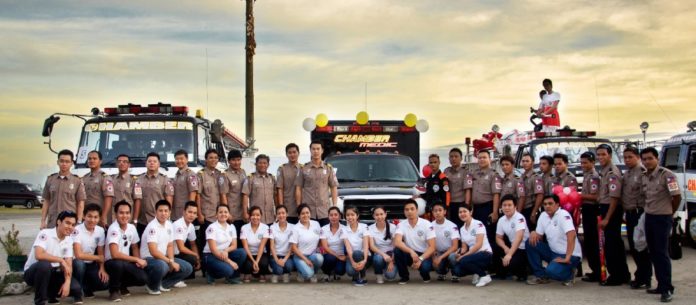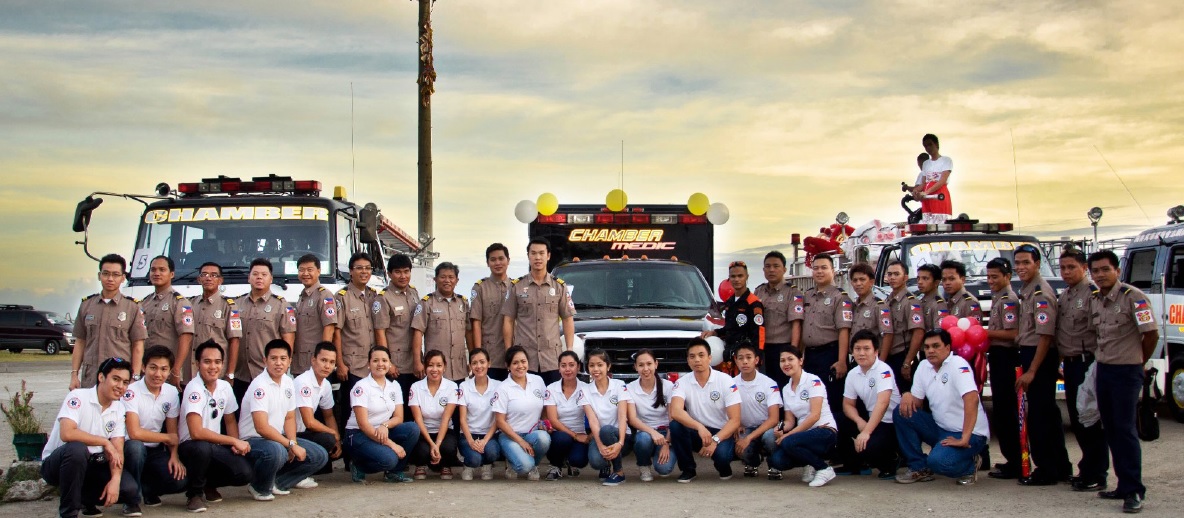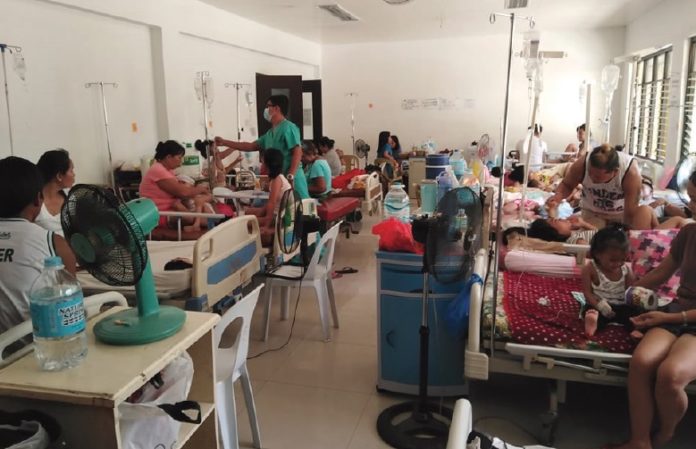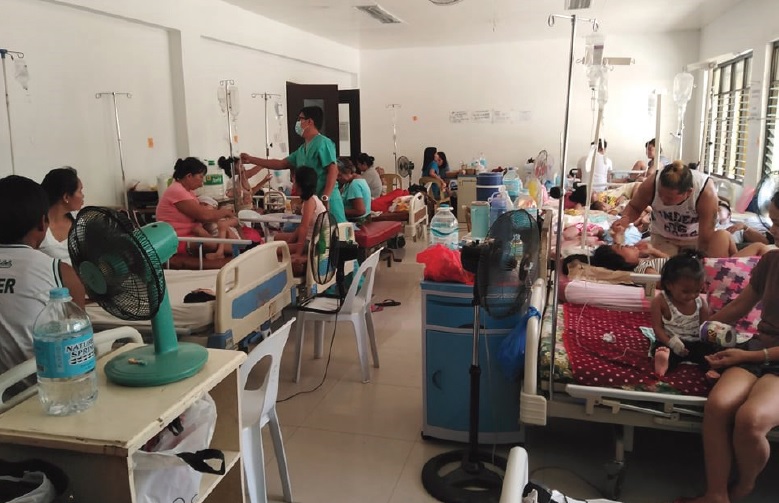TACLOBAN CITY- A woman college instructor and an alleged target listed drug personality were arrested in a buy-bust operations in Matalom, Leyte over the weekend.
Authorities identified the suspects as Mary Jane Laroa, 23, single, licensed teacher, and Kevin Lalic, 21, jobless, a drug surrenderee.
Joint elements from the Philippine Drug Enforcement Agency (PDEA) and Philippine Army together with the local police of Matalom arrested them at Barangay Sta. Fe of said town at around 9:35 p.m., July 21.
Purchased and confiscated from the suspects were eight pieces plastic sachet containing suspected “shabu” weighing around 0.25 gram with an estimated market value of P6,000 and drug paraphernalia.
The two were charged for violation of Section 5, 11, 12, and 26, Article II of RA 9165, otherwise known as the Comprehensive Dangerous Drugs Act of 2002, police said.
(RONALD O. REYES)
College teacher, drug user arrested in sting operation in Leyte town
E. Visayas tour operators earn spots in international travel fest


(Contributed photos)
TACLOBAN CITY- At least three tour companies based here in the region have earned spots in this year’s 6th edition of the International Travel Festival (ITF) in Cebu City.
“As in the years before, we brought three Eastern Visayas Tour Operators, namely, MarsDennise Travel and Tours, Hero Travel and Tours, and Kamp Kulambo,” said Bing Lumbre, product and market development officer of the Department of Tourism (DOT) in the region.
“We have been actively participating this annual event held at Ayala Center in Cebu in 2012, 2014, 2018, and 2019,” Lumbre added.
According to the tourism officer, the operators had the chance to meet, market and sell their tour packages to buyers and tourists alike in the Cebu areas for three days.
“The products mostly marketed and asked included the San Juanico cruises, island tours to Kalanggaman, the historical Limasawa, Cuatro Islas and Sambawan Islands. Others also inquired about Sohoton Caves and the Torpedo Boat Adventure in Paranas, historical tours to Balangiga, the celebration of the Leyte Landings, and the 500th year of the First Mass Anniversary,” Lumbre said.
He also thanked the support of DOT Regional Director Karen Tiopes and the travel operators for the successful event.
Hero Travel and Tours, owned and managed by Rhoel Ladera, is the top tour operator when it comes to San Juanico cruises, island tours in Kalanggaman, Cuatro Islas and Sambawan, along with tour to Sohoton caves, among other destinations in Eastern Visayas.
“The San Juanico Sunset Cruise by Hero Travel Solutions will be a big help in promoting our most iconic tourist destination in Tacloban which is the famous San Juanico Bridge. Not only can one have that instagrammable picture under the bridge but one can also explore the different islets in the strait, like the Isla de San Juanico,” Ladera said.
“Also as part of our corporate social responsibility we are helping promote the San Juan by the Bay as a stopover for our tour so we can help the people’s organization behind it, which is The San Juan by the Bay Service Cooperative. This is a project of Ms. Gina Lopez of ABS-CBN Foundation,” he added.
Meanwhile, Kamp Kolambu Travel and Tour operator disclosed that they “would like to highlight this early the upcoming 500 years commemoration of the 1st Mass in Limasawa, where we expect a lot of guests.”
Named after Rajah Kolambu, supreme ruler of Limasawa Island at the time of Magellan Landings in 1521, Kamp Kolambu offers a glamorous camping experience which vary from the usual ones in terms of size of tent with complete amenities like air conditioning, air beds with beddings, lights and full board meals.
“Limasawa Island, with its historicity and natural wonders, is a personal favorite of the outfit. We decided to make it the litmus test for a unique travel experience to include glamorous camping and activities which are curated according to the guests’ desired,” the company said.
“The camping rates vary from the kind of services requested by guests. Rates are affordable for middle class tourists,” wrote the Kamp Kolambu in its Facebook page.
Kamp Kolambu can also offer the same concept in other tourist destinations in the region, provided that there is electricity supply.
“We also offer Tacloban City tours with a twist- remembrance tours like Leyte Landings and Yolanda tours, Kalanggaman and other island destinations, faith and pilgrimage tours, and general adventure tours,” the Kamp Kulambo operator said.
The recently-concluded 6th ITF was attended by more than 100 exhibitors from airline companies, hotels, and resorts.
(RONALD O. REYES)
Tacloban Chamber Volunteer Fire Brigade in need of emergency medical responders


TACLOBAN CITY- The Tacloban Chamber Volunteer Fire Brigade Association Inc. is now accepting new applicants to be trained as emergency medical responders.
Those interested should be 18 to 30 years old male or female, must have a strong spirit of volunteerism, and preferably finished medical-related courses.
Also, an applicant must be physically and mentally fit and willing to undergo intensive training.
With its almost 100 volunteers, the chamber fire brigade has been saving and protecting lives and properties since 1980, according to its fire chief Arjan Antig.
In an interview, Antig called on the public to continue to support local volunteer fire brigades.
At present, the chamber fire brigade has two firetrucks and one ambulance.
Interested applicants must bring two pieces 2×2 ID pictures, barangay and police clearance, medical certificate, and fill out an application form at Chamber base at TFCCCI Building, 174 Justice Romualdez Street, Tacloban City.
They may also contact 555/ 321-3331/ 523-8515/ 0917-782-1555/ 0918-315-0300.
Recruitment is until August 31, 2019 while the training will start on September 2019.
(RONALD O. REYES)
Group asks property buyers to transact only with legitimate real estate brokers
TACLOBAN CITY- The Tacloban, Leyte-Samar-Biliran Chapter of the Real Estate Brokers of the Philippines (REBAP) urges the real estate owners planning to sell their properties to transact with legal and licensed brokers for their safety as well as the buyers.
Legal and licensed brokers are recognized and issued with licensed by the Philippine Regulation Commission (PRC).
According to Joy Valledor, president of Tac-Ley-Sam-Bil REBAP chapter, several reports have reached them that double sales of property happened, and reports on larger sales commission compared to the actual sales of the real property were agents were reportedly unlicensed.
Their group is doubling their efforts to make the public aware of their services since it came to their attention that the so called ‘coluroms’ are being aggressive in their efforts to collect bigger commissions.
Valledor added that when selling and buying real estate property, owners should only transact with licensed real estate brokers and accredited salespersons.
“They should always ask for the agents or brokers PRC ID registration number” she said.
Al Marzol, the chapter’s immediate past president, said that what makes them different from their unlicensed counter part is that they conduct due diligence before they offer a buyer a property for sale and that their commission is at the reasonable percent and are regulated, compare to those unlicensed whose purpose is really to gain, to the point of short changing the owner of the property.
He added that sometimes these unregistered agents earn more than the owner of the property.
Jhumer Operio, vice president of the chapter, emphasized that instead of competing with them, they are hopeful that these unlicensed agents can work with them instead.
“We were once like them. However, upon the passage of RA 9646or the Real Estate Service Act of the Philippines, they were compelled to take the necessary exam passed it and have their license from PRC” Opeña added.
To date, a private school in Palo, Leyte is offering the course Bachelor of Science in Real Estate Brokerage.
The Department of Interior and Local Government (DILG) in a memorandum circular numbered 2019-86 addressed to all local government units mandated to strictly implement RA 9646.
The law was enacted to further the policy of the state to develop and nurture a corps of technically competent, responsible and respected professional real estate service practitioners through proper and effective regulation and supervision.
Valledor said that they are not threatened by the unregistered agents as they are more serious in making people aware that there are licensed agents, and that what these unregistered agents are doing is detrimental to their group, because they are more profit-oriented, they want that the future estate brokers are protected as well.
Valledor added that the registered agents goes beyond after the commissions were given as they are for the protection of the property owners as well as the buyer.
Ultimately their group wanted the people to be aware of the existence of licensed real estate brokers and the advantage of dealing with them compared to unlicensed agents.
Their chapter is in existence since 2016 with 54 members and 27 active members.
(LIZBETH ANN A.ABELLA)
EV’s 100 millionth symbolic babies turn 5
TACLOBAN CITY – The region’s 100 millionth symbolic babies will turn five on Saturday(July 27) and much is expected on their overall development needs with the growing challenge to engage their families in their capacity to respond to these needs.
The Commission on Population and Development(Popcom) Regional Office VIII continues to monitor the status of these children as a reiteration of the agency’s advocacy through the years that every child should be born wanted, and basic rights on social services such as health and education are ensured for the child’s total development.
Aside from monitoring their overall status, Popcom-8 will likewise be providing them with school supplies and other basic necessities as they turn five years old this year.
Region 8 has six 100 millionth babies, Rian Go of Tacloban City; Miller Josh Tondo of Tanauan, Leyte; Catalea Blaire of San Juan, Southern Leyte; Sunrey Abonales of Catarman, Northern Samar; Jody Cervantes of Borongan City and Joven Rey Arsenio of Catbalogan City in Samar.
The birth of these symbolic babies in 2014 was considered a demographic event which was an institutional reality-check that the country was then registering a 100-million population record. The country’s population is estimated to reach 108,885,096 Filipinos by December 31, 2019 based on a 1.7% growth rate posted in the 2015 census by the Philippine Statistics Authority.
Also, the birth of these babies five years ago called for paying proactive attention to the importance of maternal and neonatal health as well as promote responsible parenthood and family planning among Filipino families. It was also seen as a challenge to the Philippines as its socio-economic and political situation struggle to give the citizenry a better quality of life.
This year’s birthday of the 100 millionth babies, carries the theme “Bigyang halaga ang bawat Pinoy sa Pag-unlad, Ngayon at Bukas. Sa Ikalimang Taon ni Baby, Pagtutulungan Tungo sa Maunlad at Malusog na Kinabukasan”.
Popcom VIII will also utilize a tool that will help determine the type of support that still needs to be extended to the symbolic babies and their respective families in the coming years.
The birth of the 100 millionth symbolic babies nationwide is still a challenge to the government as these babies are expected to demand an increase of the family’s capacity to provide for the needs of their children. The attainment of zero unmet need for modern family planning envisions to help millions of poor Filipino families achieve their desired family size through access to FP information and services.
(LIZBETH ANN A.ABELLA)
Dengue cases in E. Samar is in the status of both alert and epidemic


(SDC/PIA8-Eastern Samar)
BORONGAN CITY-The Eastern Samar Provincial Health Office (ESPHO) reported that the dengue fever suspected cases in Eastern Samar is both in the alert and epidemic status.
According to Provincial Health Office (PHO) Chief, technical section, Dr. Rodel Delgado, the province fell below the alert threshold for dengue for 13 weeks, but this week, the province breached both the alert and epidemic threshold for dengue.
Delgado said that the municipalities of Balangkayan, Lawaan, Maydolong, San-Julian, Sulat and Taft as well as the city of Borongan, have also breached the epidemic threshold while the municipalities of Balangiga, Giporlos, Llorente and San Policarpo have reached the alert threshold.
In a press conference on July 22, Delgado reported that Eastern Samar has 130 new cases of suspected dengue fever over the past three weeks.
The areas reporting the most cases of suspected dengue these past three weeks are Borongan City with 59 cases, Maydolong-13 cases, Taft-12 cases, Sulat-11 cases, and San-Julian with nine cases.
He said that from January 1 to July 19, 2019, the province has a total of 803 suspected dengue fever cases in 22 out of 23 municipalities and one city, and 276 barangays affected.
“This represents an 86 percent increase of dengue cases in the province compared with a similar period last year. This increase of dengue cases for the year was mainly due to the high number of cases seen during the first 12 weeks of the year and the increase of cases in the past three weeks,” Delgado said.
Most affected are Borongan City with 147 cases, Guiuan-107, Taft-58, Quinapondan-54, Gen. Mac-Arthur-51, and Maydolong-51.
Some nine deaths of suspected dengue cases were also reported since the start of 2019.
The most recent death was recorded in Taft – one on June 29.
Four deaths were recorded in Guiuan, one in Gen. Mac-Arthur, one in Hernani, one in Borongan City, and one in Maydolong.
Delgado further said, “Among the 803 cases reported, 144 had consultation at the Out Patient Department (OPD), while 659 cases were admitted in the government and private hospitals.”
Most of the recorded cases were children aged 11 to 20 years old with 339 cases; followed by aged one to 10 years old with 313 cases; 21-30 years old with 73; 31-40 years old with 33 cases; less than one year old with 22 cases; 41-50 years old with 15 cases; and over 50 years old with eight cases.
The ESPHO calls the public to be aware or rather seek early consultation if suffering from fever.
Dengue is an acute infectious disease manifested initially with fever.
The fever which may last from two to seven days with the following signs and symptoms: joint and muscle pain, severe headache and pain behind the eyes, weakness, and no appetite.
Some symptoms like vomiting, internal bleeding, skin rashes and abdominal pains are danger signs.
During the press conference, Provincial Administrator Nelson Cortez said that the province has already purchased dengue rapid tests.
He added that the hospital will soon open additional wards in the ESPHO exclusive for pediatric and adult dengue patients.
The Sangguniang Panlalawigan also approved last Friday, July 19 the authority of the governor to enter a memorandum of agreement to private clinics with lab services such as computerized tomography( CT)Scan.
Then there is the agreement with private pharmacies, if in case there is no medicine in the government hospitals.
The patients can get the medicines in the private pharmacy with assistance from the Malasakit Center (MC) which has an initial fund of P5 million.
The MC will be the one to pay for all the medicines and laboratory tests of patients in the private clinics.
Cortez said that Governor Ben Evardone allocated a big amount to buy medicines in the government hospitals.
Presently, the province activated the Dengue Task Force in all affected municipalities/city based on their dengue status alert level.
The Provincial Health Office personnel will also conduct larval survey, search and destroy, misting and fogging.
Cortez advised the local government units to work in constant coordination with the district hospitals, and ESPHO. (NBQ/SDC/PIA-Eastern Samar)
